parking brake CHEVROLET MONTE CARLO 2007 6.G Owners Manual
[x] Cancel search | Manufacturer: CHEVROLET, Model Year: 2007, Model line: MONTE CARLO, Model: CHEVROLET MONTE CARLO 2007 6.GPages: 456, PDF Size: 2.43 MB
Page 87 of 456
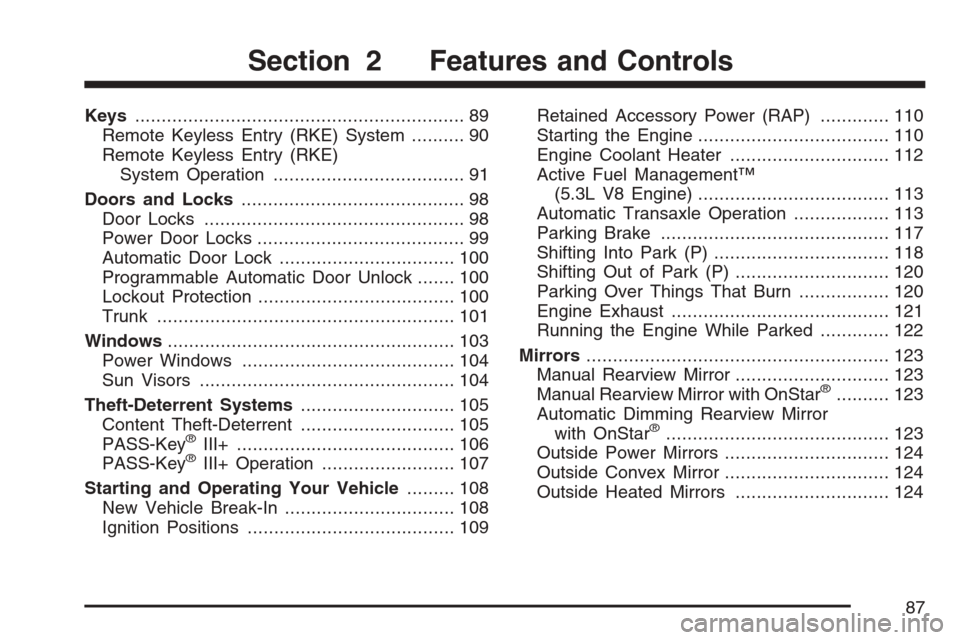
Keys.............................................................. 89
Remote Keyless Entry (RKE) System.......... 90
Remote Keyless Entry (RKE)
System Operation.................................... 91
Doors and Locks.......................................... 98
Door Locks................................................. 98
Power Door Locks....................................... 99
Automatic Door Lock................................. 100
Programmable Automatic Door Unlock....... 100
Lockout Protection..................................... 100
Trunk........................................................ 101
Windows...................................................... 103
Power Windows........................................ 104
Sun Visors................................................ 104
Theft-Deterrent Systems............................. 105
Content Theft-Deterrent............................. 105
PASS-Key
®III+......................................... 106
PASS-Key®III+ Operation......................... 107
Starting and Operating Your Vehicle......... 108
New Vehicle Break-In................................ 108
Ignition Positions....................................... 109Retained Accessory Power (RAP)............. 110
Starting the Engine.................................... 110
Engine Coolant Heater.............................. 112
Active Fuel Management™
(5.3L V8 Engine).................................... 113
Automatic Transaxle Operation.................. 113
Parking Brake........................................... 117
Shifting Into Park (P) ................................. 118
Shifting Out of Park (P)............................. 120
Parking Over Things That Burn................. 120
Engine Exhaust......................................... 121
Running the Engine While Parked............. 122
Mirrors......................................................... 123
Manual Rearview Mirror............................. 123
Manual Rearview Mirror with OnStar
®.......... 123
Automatic Dimming Rearview Mirror
with OnStar
®.......................................... 123
Outside Power Mirrors............................... 124
Outside Convex Mirror............................... 124
Outside Heated Mirrors............................. 124
Section 2 Features and Controls
87
Page 114 of 456
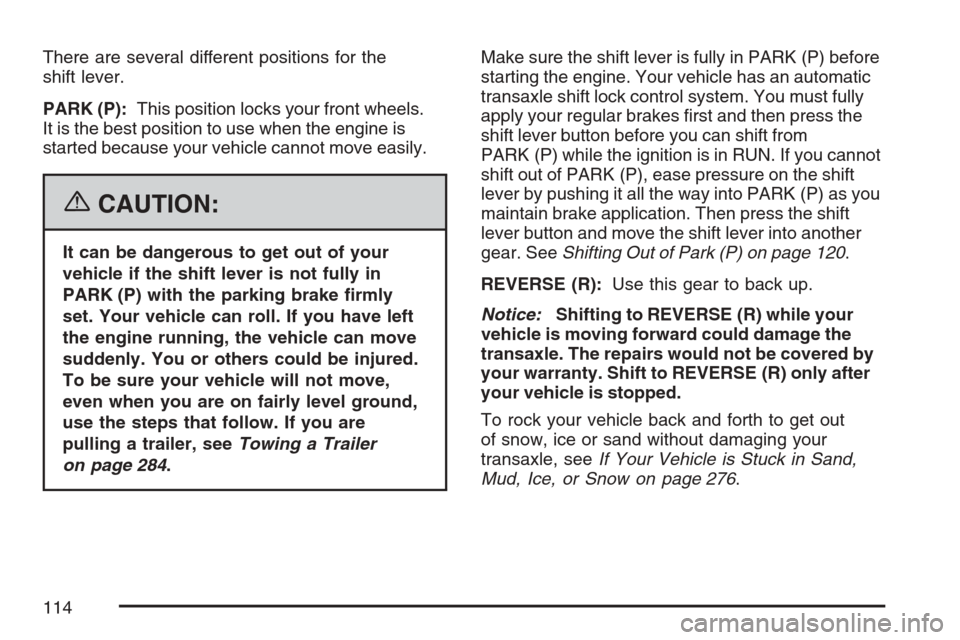
There are several different positions for the
shift lever.
PARK (P):This position locks your front wheels.
It is the best position to use when the engine is
started because your vehicle cannot move easily.
{CAUTION:
It can be dangerous to get out of your
vehicle if the shift lever is not fully in
PARK (P) with the parking brake �rmly
set. Your vehicle can roll. If you have left
the engine running, the vehicle can move
suddenly. You or others could be injured.
To be sure your vehicle will not move,
even when you are on fairly level ground,
use the steps that follow. If you are
pulling a trailer, seeTowing a Trailer
on page 284.Make sure the shift lever is fully in PARK (P) before
starting the engine. Your vehicle has an automatic
transaxle shift lock control system. You must fully
apply your regular brakes �rst and then press the
shift lever button before you can shift from
PARK (P) while the ignition is in RUN. If you cannot
shift out of PARK (P), ease pressure on the shift
lever by pushing it all the way into PARK (P) as you
maintain brake application. Then press the shift
lever button and move the shift lever into another
gear. SeeShifting Out of Park (P) on page 120.
REVERSE (R):Use this gear to back up.
Notice:Shifting to REVERSE (R) while your
vehicle is moving forward could damage the
transaxle. The repairs would not be covered by
your warranty. Shift to REVERSE (R) only after
your vehicle is stopped.
To rock your vehicle back and forth to get out
of snow, ice or sand without damaging your
transaxle, seeIf Your Vehicle is Stuck in Sand,
Mud, Ice, or Snow on page 276.
114
Page 116 of 456
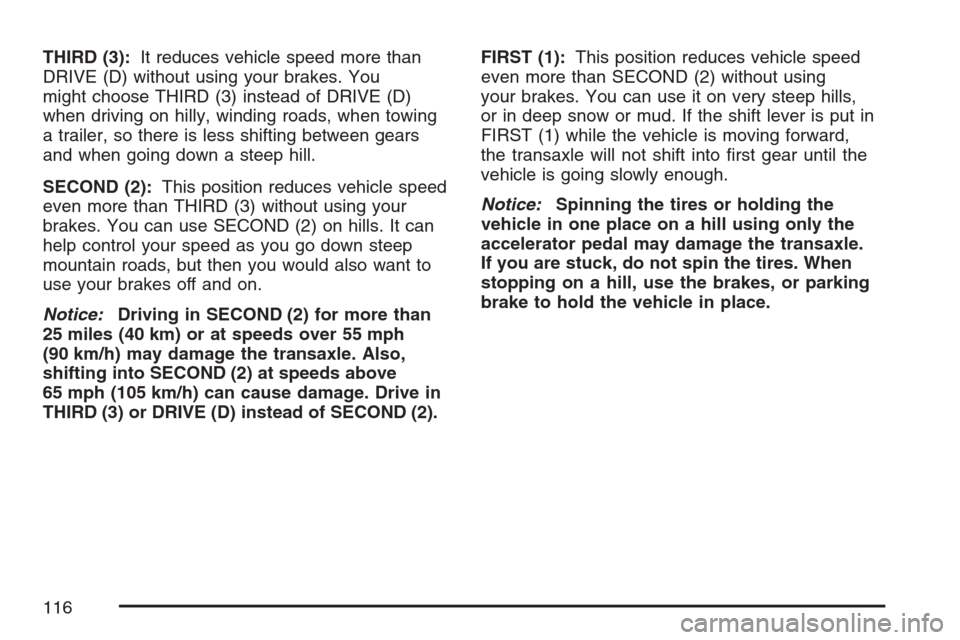
THIRD (3):It reduces vehicle speed more than
DRIVE (D) without using your brakes. You
might choose THIRD (3) instead of DRIVE (D)
when driving on hilly, winding roads, when towing
a trailer, so there is less shifting between gears
and when going down a steep hill.
SECOND (2):This position reduces vehicle speed
even more than THIRD (3) without using your
brakes. You can use SECOND (2) on hills. It can
help control your speed as you go down steep
mountain roads, but then you would also want to
use your brakes off and on.
Notice:Driving in SECOND (2) for more than
25 miles (40 km) or at speeds over 55 mph
(90 km/h) may damage the transaxle. Also,
shifting into SECOND (2) at speeds above
65 mph (105 km/h) can cause damage. Drive in
THIRD (3) or DRIVE (D) instead of SECOND (2).FIRST (1):This position reduces vehicle speed
even more than SECOND (2) without using
your brakes. You can use it on very steep hills,
or in deep snow or mud. If the shift lever is put in
FIRST (1) while the vehicle is moving forward,
the transaxle will not shift into �rst gear until the
vehicle is going slowly enough.
Notice:Spinning the tires or holding the
vehicle in one place on a hill using only the
accelerator pedal may damage the transaxle.
If you are stuck, do not spin the tires. When
stopping on a hill, use the brakes, or parking
brake to hold the vehicle in place.
116
Page 117 of 456
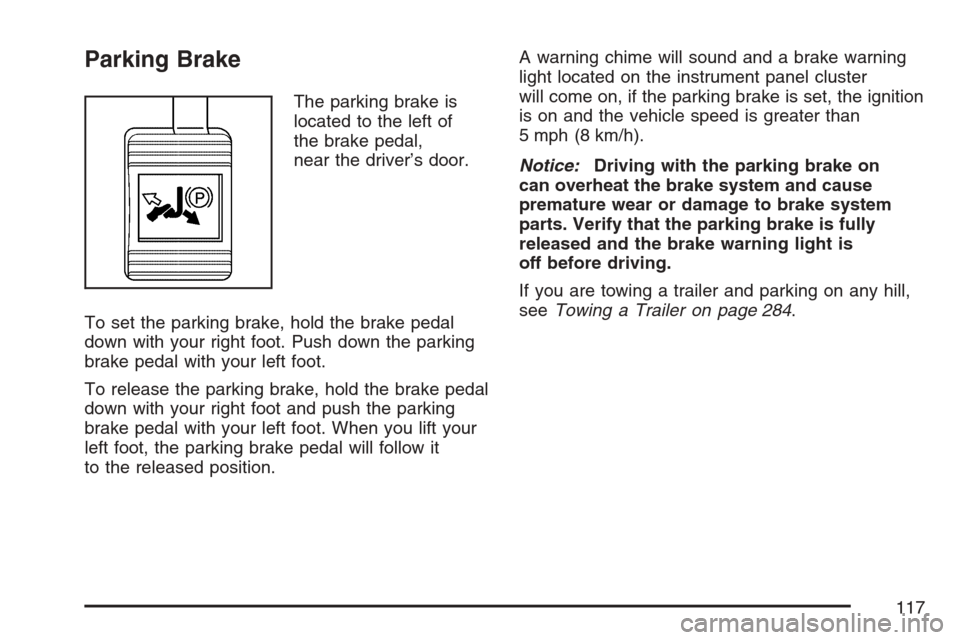
Parking Brake
The parking brake is
located to the left of
the brake pedal,
near the driver’s door.
To set the parking brake, hold the brake pedal
down with your right foot. Push down the parking
brake pedal with your left foot.
To release the parking brake, hold the brake pedal
down with your right foot and push the parking
brake pedal with your left foot. When you lift your
left foot, the parking brake pedal will follow it
to the released position.A warning chime will sound and a brake warning
light located on the instrument panel cluster
will come on, if the parking brake is set, the ignition
is on and the vehicle speed is greater than
5 mph (8 km/h).
Notice:Driving with the parking brake on
can overheat the brake system and cause
premature wear or damage to brake system
parts. Verify that the parking brake is fully
released and the brake warning light is
off before driving.
If you are towing a trailer and parking on any hill,
seeTowing a Trailer on page 284.
117
Page 118 of 456
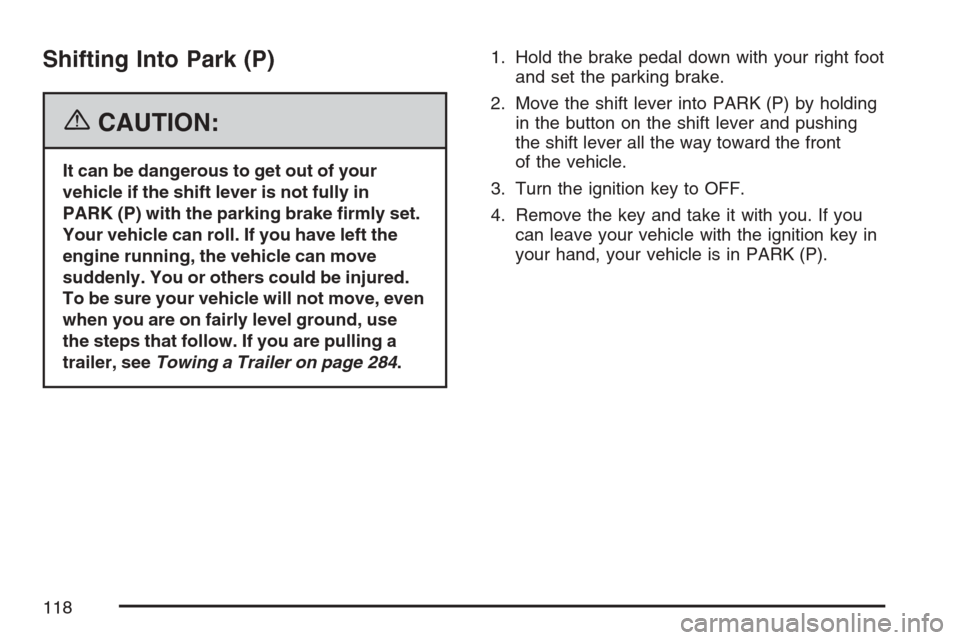
Shifting Into Park (P)
{CAUTION:
It can be dangerous to get out of your
vehicle if the shift lever is not fully in
PARK (P) with the parking brake �rmly set.
Your vehicle can roll. If you have left the
engine running, the vehicle can move
suddenly. You or others could be injured.
To be sure your vehicle will not move, even
when you are on fairly level ground, use
the steps that follow. If you are pulling a
trailer, seeTowing a Trailer on page 284.1. Hold the brake pedal down with your right foot
and set the parking brake.
2. Move the shift lever into PARK (P) by holding
in the button on the shift lever and pushing
the shift lever all the way toward the front
of the vehicle.
3. Turn the ignition key to OFF.
4. Remove the key and take it with you. If you
can leave your vehicle with the ignition key in
your hand, your vehicle is in PARK (P).
118
Page 119 of 456
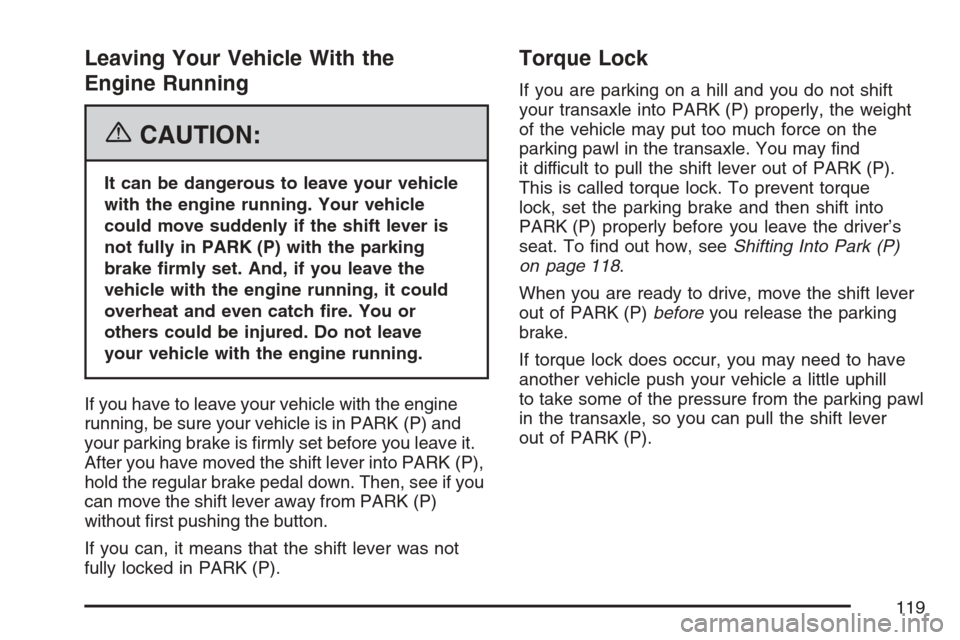
Leaving Your Vehicle With the
Engine Running
{CAUTION:
It can be dangerous to leave your vehicle
with the engine running. Your vehicle
could move suddenly if the shift lever is
not fully in PARK (P) with the parking
brake �rmly set. And, if you leave the
vehicle with the engine running, it could
overheat and even catch �re. You or
others could be injured. Do not leave
your vehicle with the engine running.
If you have to leave your vehicle with the engine
running, be sure your vehicle is in PARK (P) and
your parking brake is �rmly set before you leave it.
After you have moved the shift lever into PARK (P),
hold the regular brake pedal down. Then, see if you
can move the shift lever away from PARK (P)
without �rst pushing the button.
If you can, it means that the shift lever was not
fully locked in PARK (P).
Torque Lock
If you are parking on a hill and you do not shift
your transaxle into PARK (P) properly, the weight
of the vehicle may put too much force on the
parking pawl in the transaxle. You may �nd
it difficult to pull the shift lever out of PARK (P).
This is called torque lock. To prevent torque
lock, set the parking brake and then shift into
PARK (P) properly before you leave the driver’s
seat. To �nd out how, seeShifting Into Park (P)
on page 118.
When you are ready to drive, move the shift lever
out of PARK (P)beforeyou release the parking
brake.
If torque lock does occur, you may need to have
another vehicle push your vehicle a little uphill
to take some of the pressure from the parking pawl
in the transaxle, so you can pull the shift lever
out of PARK (P).
119
Page 120 of 456
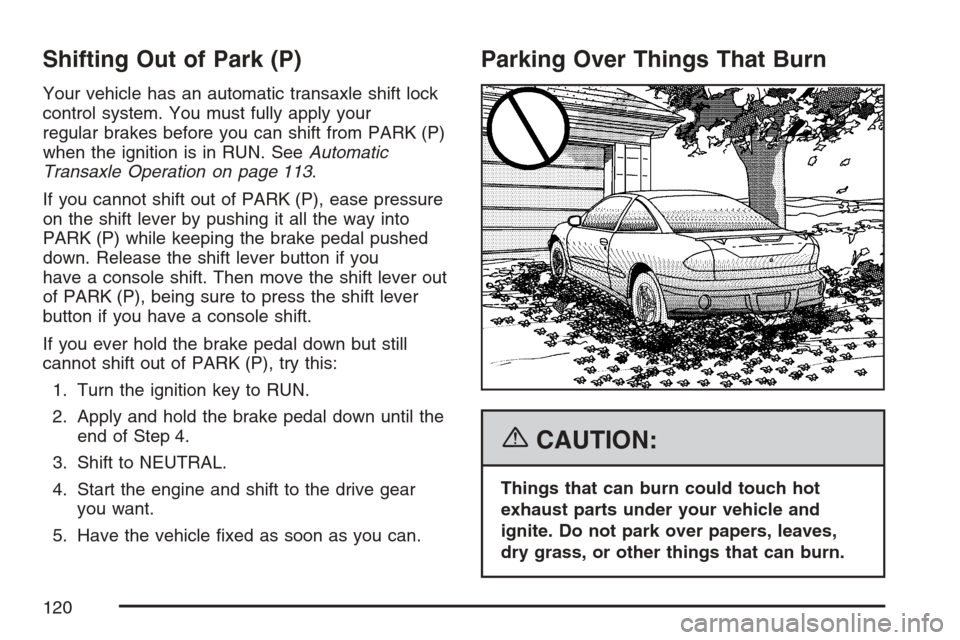
Shifting Out of Park (P)
Your vehicle has an automatic transaxle shift lock
control system. You must fully apply your
regular brakes before you can shift from PARK (P)
when the ignition is in RUN. SeeAutomatic
Transaxle Operation on page 113.
If you cannot shift out of PARK (P), ease pressure
on the shift lever by pushing it all the way into
PARK (P) while keeping the brake pedal pushed
down. Release the shift lever button if you
have a console shift. Then move the shift lever out
of PARK (P), being sure to press the shift lever
button if you have a console shift.
If you ever hold the brake pedal down but still
cannot shift out of PARK (P), try this:
1. Turn the ignition key to RUN.
2. Apply and hold the brake pedal down until the
end of Step 4.
3. Shift to NEUTRAL.
4. Start the engine and shift to the drive gear
you want.
5. Have the vehicle �xed as soon as you can.
Parking Over Things That Burn
{CAUTION:
Things that can burn could touch hot
exhaust parts under your vehicle and
ignite. Do not park over papers, leaves,
dry grass, or other things that can burn.
120
Page 122 of 456
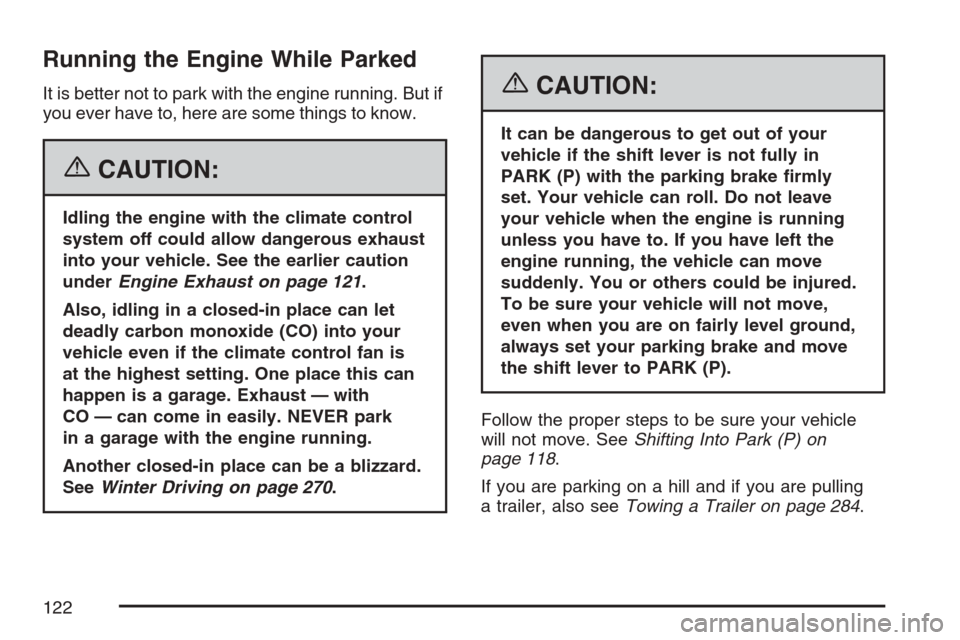
Running the Engine While Parked
It is better not to park with the engine running. But if
you ever have to, here are some things to know.
{CAUTION:
Idling the engine with the climate control
system off could allow dangerous exhaust
into your vehicle. See the earlier caution
underEngine Exhaust on page 121.
Also, idling in a closed-in place can let
deadly carbon monoxide (CO) into your
vehicle even if the climate control fan is
at the highest setting. One place this can
happen is a garage. Exhaust — with
CO — can come in easily. NEVER park
in a garage with the engine running.
Another closed-in place can be a blizzard.
SeeWinter Driving on page 270.
{CAUTION:
It can be dangerous to get out of your
vehicle if the shift lever is not fully in
PARK (P) with the parking brake �rmly
set. Your vehicle can roll. Do not leave
your vehicle when the engine is running
unless you have to. If you have left the
engine running, the vehicle can move
suddenly. You or others could be injured.
To be sure your vehicle will not move,
even when you are on fairly level ground,
always set your parking brake and move
the shift lever to PARK (P).
Follow the proper steps to be sure your vehicle
will not move. SeeShifting Into Park (P) on
page 118.
If you are parking on a hill and if you are pulling
a trailer, also seeTowing a Trailer on page 284.
122
Page 154 of 456
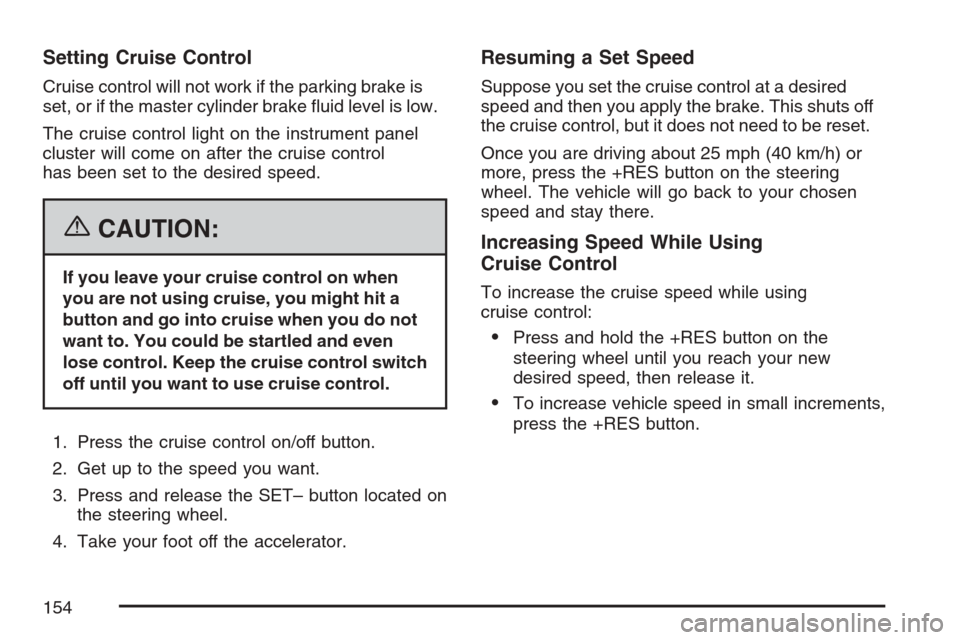
Setting Cruise Control
Cruise control will not work if the parking brake is
set, or if the master cylinder brake �uid level is low.
The cruise control light on the instrument panel
cluster will come on after the cruise control
has been set to the desired speed.
{CAUTION:
If you leave your cruise control on when
you are not using cruise, you might hit a
button and go into cruise when you do not
want to. You could be startled and even
lose control. Keep the cruise control switch
off until you want to use cruise control.
1. Press the cruise control on/off button.
2. Get up to the speed you want.
3. Press and release the SET– button located on
the steering wheel.
4. Take your foot off the accelerator.
Resuming a Set Speed
Suppose you set the cruise control at a desired
speed and then you apply the brake. This shuts off
the cruise control, but it does not need to be reset.
Once you are driving about 25 mph (40 km/h) or
more, press the +RES button on the steering
wheel. The vehicle will go back to your chosen
speed and stay there.
Increasing Speed While Using
Cruise Control
To increase the cruise speed while using
cruise control:
Press and hold the +RES button on the
steering wheel until you reach your new
desired speed, then release it.
To increase vehicle speed in small increments,
press the +RES button.
154
Page 178 of 456
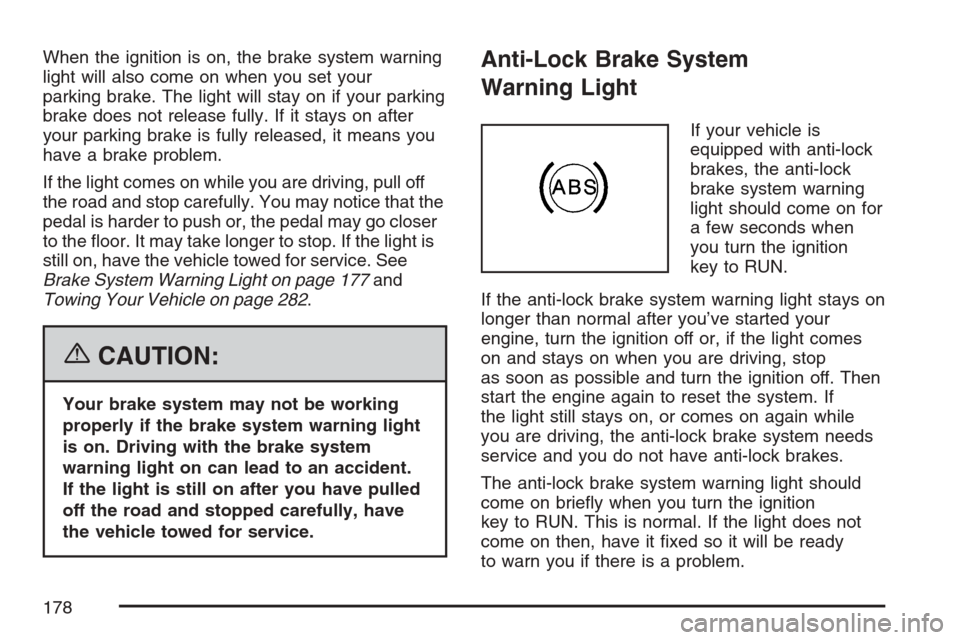
When the ignition is on, the brake system warning
light will also come on when you set your
parking brake. The light will stay on if your parking
brake does not release fully. If it stays on after
your parking brake is fully released, it means you
have a brake problem.
If the light comes on while you are driving, pull off
the road and stop carefully. You may notice that the
pedal is harder to push or, the pedal may go closer
to the �oor. It may take longer to stop. If the light is
still on, have the vehicle towed for service. See
Brake System Warning Light on page 177and
Towing Your Vehicle on page 282.
{CAUTION:
Your brake system may not be working
properly if the brake system warning light
is on. Driving with the brake system
warning light on can lead to an accident.
If the light is still on after you have pulled
off the road and stopped carefully, have
the vehicle towed for service.
Anti-Lock Brake System
Warning Light
If your vehicle is
equipped with anti-lock
brakes, the anti-lock
brake system warning
light should come on for
a few seconds when
you turn the ignition
key to RUN.
If the anti-lock brake system warning light stays on
longer than normal after you’ve started your
engine, turn the ignition off or, if the light comes
on and stays on when you are driving, stop
as soon as possible and turn the ignition off. Then
start the engine again to reset the system. If
the light still stays on, or comes on again while
you are driving, the anti-lock brake system needs
service and you do not have anti-lock brakes.
The anti-lock brake system warning light should
come on brie�y when you turn the ignition
key to RUN. This is normal. If the light does not
come on then, have it �xed so it will be ready
to warn you if there is a problem.
178